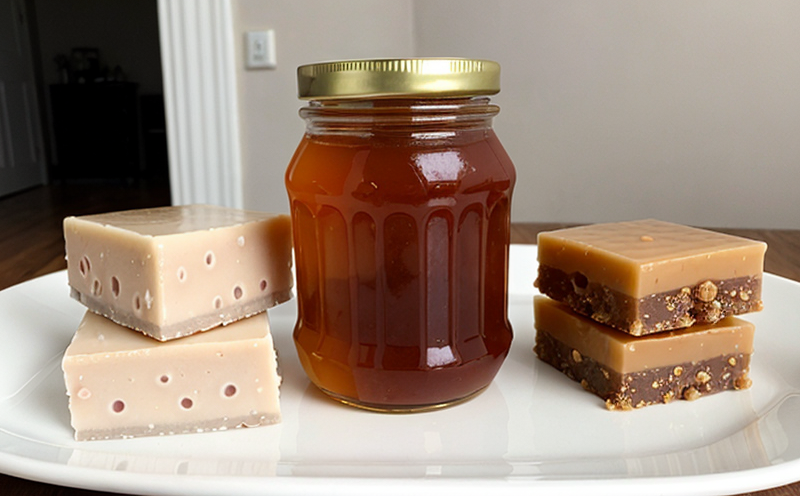AOAC 920.180 Sugars and Sucrose Testing in Honey
The AOAC International Standard Method 920.180 is widely recognized as a robust protocol for the determination of sugars, including sucrose, glucose, fructose, and other reducing sugars, in honey products. This method is particularly valuable for quality control, compliance assurance, and research purposes within the food and feed testing sector. Sugar content is a critical parameter that influences not only the taste but also the shelf life and stability of honey. Accurate measurement ensures adherence to industry standards, consumer expectations, and regulatory requirements.
AOAC 920.180 employs enzymatic hydrolysis followed by gas chromatography for precise quantification of sugars in honey samples. The process involves several steps that are crucial for obtaining reliable results:
- Sample Preparation: Honey is diluted with distilled water to ensure accurate measurement.
- Enzymatic Hydrolysis: Specific enzymes convert sucrose into glucose and fructose, allowing for a more comprehensive sugar profile analysis.
- Colorimetric Reaction: The liberated reducing sugars undergo a colorimetric reaction that is proportional to their concentration.
- Gas Chromatography: The resulting mixture is analyzed using gas chromatography to separate and quantify individual sugars.
The method's accuracy and precision are further enhanced by the use of certified reference materials, which provide a consistent benchmark for calibration. This ensures that results are repeatable and comparable across different laboratories and testing facilities.
Compliance with AOAC 920.180 is essential for food manufacturers and suppliers who must ensure their products meet stringent quality standards. Accurate sugar content analysis helps in identifying adulteration, ensuring product authenticity, and maintaining brand integrity. Additionally, this method supports research into honey composition, which can inform breeding programs to improve the quality of future honey varieties.
For those seeking to validate their testing processes or comply with regulatory requirements, AOAC 920.180 provides a standardized approach that is widely accepted in the global food industry. This method not only enhances product quality but also contributes to consumer trust and satisfaction.
Applied Standards
| Standard Reference | Description |
|---|---|
| AOAC International Standard Method 920.180 | Enzymatic hydrolysis followed by gas chromatography for determination of sugars and sucrose in honey. |
| ISO 6579:2014 | Determination of glucose, fructose, and total reducing sugar content in honey. |
Scope and Methodology
| Scope | Description |
|---|---|
| Determination of sugars, including sucrose, glucose, fructose, and other reducing sugars in honey. | |
| Validation for compliance with industry standards and regulatory requirements. |
The methodology involves several key steps:
- Sampling: Representative samples are collected from the production or storage areas to ensure a comprehensive analysis.
- Dilution: Samples are diluted with distilled water to facilitate accurate measurement of sugar content.
- Enzymatic Hydrolysis: Specific enzymes are used to break down sucrose into glucose and fructose, enhancing the precision of subsequent analyses.
- Colorimetric Reaction: The liberated reducing sugars undergo a colorimetric reaction that is proportional to their concentration. This step ensures accurate quantification by providing a direct correlation between sugar content and the intensity of the resulting color.
- Gas Chromatography: Separation and quantification of individual sugars are achieved through gas chromatographic analysis, which provides highly accurate results.
The method is validated using certified reference materials, ensuring that the results obtained are consistent and reliable. This approach guarantees that the testing process adheres to strict quality control measures and meets the stringent requirements set by regulatory bodies.
Why Choose This Test
- Regulatory Compliance: AOAC 920.180 ensures compliance with international standards, facilitating trade within the global food industry.
- Quality Assurance: Accurate sugar content analysis helps in identifying adulteration and maintaining product authenticity.
- Research Support: The method provides a robust framework for research into honey composition, contributing to improved breeding programs and product quality.
- Consumer Trust: Ensuring accurate sugar content builds consumer confidence in the integrity of food products.
- Consistency: Certified reference materials guarantee consistent and reliable results across different laboratories and testing facilities.
- Precision: The enzymatic hydrolysis process enhances the precision of sugar quantification, providing accurate results even for complex honey samples.
- Comprehensive Analysis: The method allows for a detailed analysis of various sugars present in honey, offering insights into product composition and quality.
The AOAC 920.180 method is an indispensable tool for those involved in the food and feed testing sector, particularly in the honey and confectionery category. Its comprehensive approach ensures that sugar content analysis is accurate, reliable, and compliant with international standards.





